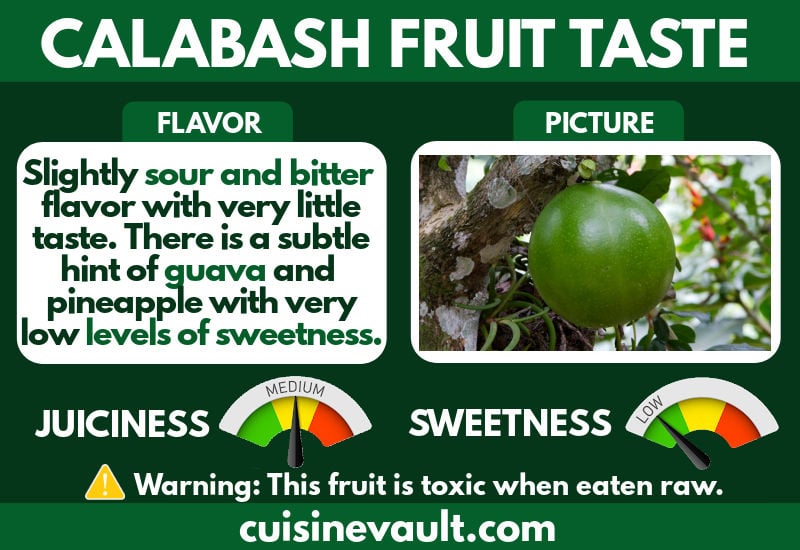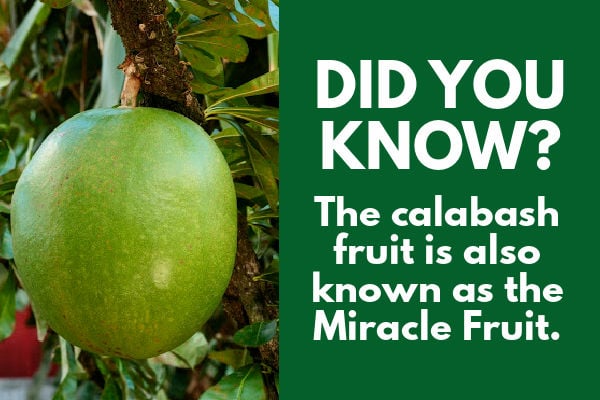The calabash fruit tree can be found growing in warm climates throughout Asia, South America, Central America, and Florida. They are mostly used for shade and ornamental purposes as the pulp and seeds can be toxic when eaten raw.
The fruit is used in traditional medicine and also makes a nutritious juice once cooked. If you would like to know what a calabash fruit tastes like then keep reading. We're about to take a close look at its flavor, texture, and some handy facts.
What do calabash fruits taste like?
The flesh of a calabash fruit can be toxic and we don't recommend eating the raw flesh or small white seeds. Those that have tried eating the raw pulp in small amounts have found that a calabash has a slightly sour and bitter flavor with very little taste. There is a subtle hint of guava and pineapple with very low levels of sweetness. Some compare the fruit to a soursop, only the calabash is sourer.
The soft, white pulp can easily be scooped out of the fruit and boiled with water to make calabash juice. This black-colored drink has a mild taste without any sweetness or sourness. It is slightly bitter with a green taste and an aroma like squash and coconut water.
 Is calabash juice any good?
Is calabash juice any good?
We taste-tested the juice once and found it tolerable but not something we would drink for enjoyment. It lacks sweetness and other tropical juices taste better. However, if you’re looking for a juice that’s got less sugar than most regular juices, and is packed with vitamin C, then this is a good choice.
Interesting reading:
What do gac fruits taste like?
What do black sapotes taste like?
How to make calabash fruit juice
Extracting a bottle of juice from this fruit is different from the regular juicing methods. Instead, the secret is to cook it, so follow these steps to make your own.
Ingredients
- ½ a large calabash fruit
- 1 pint water
Method
- Carefully slice the fruit in half using a large sharp knife. If the rind is too hard to cut, then you should use a saw.
- Use a spoon to scoop the flesh out of the fruit and add it to a large pot with the water. Heat on medium-high until boiling then reduce to a simmer and cook for one hour.
- Remove the pot from the heat and allow to cool a little. Pour the liquid through a strainer and discard the solids.
- Use a funnel to pour the juice into a bottle and refrigerate.
Note: You can adjust the amount of water depending on your personal preference. Try using different quantities to see what works best for you.
Culinary uses
- The seeds can be roasted with wheat to make a refreshing coffee substitute.
- The seeds can be cooked and used to make tea.
- Calabash leaves from the plant can be cooked in casseroles and soups.
- Ground seeds can be boiled with water and sugar to make a syrup that is useful in making confectionery.
Nutritional benefits
The calabash fruit has a range of health benefits and is known as the miracle fruit. It is especially high in vitamin C, making it a popular remedy for treating colds.
The calabash is also believed to help with intestinal irregularities, diarrhea, menstrual pain, and pneumonia. The bark can be used to clean wounds.
 Fast facts about the calabash fruit
Fast facts about the calabash fruit
- The calabash tree has the botanical name Crescentia cujete and is part of the Bignoniaceae family.
- Calabash rind is firm and can be used to make cups, bowls, and other containers.
- The tree produces fruit that grow up to 20 inches in diameter. It can flower and fruit in any season throughout the year.
- Calabash pulp can be used in traditional medicine as a laxative, expectorant, or emollient.
Interesting reading: How to replace delicata squash in a recipe.
Summing up
The calabash fruit grows in abundance in tropical and subtropical climates. Although the fruit is readily available in these locations, the trees are more commonly used for shade and landscaping.
The raw white pulp is toxic and is best boiled with water and strained for its juice. It has a green, slightly bitter taste without any overpowering flavor or aroma. While this fruit is unlikely to win any awards for its flavor, it is considered a "miracle fruit" with a range of health benefits. If you're drinking it for this reason, then we suggest combining it with other ingredients like banana and apple juice.
Are you considering growing a calabash tree or have you found the fresh fruit or juice for sale? Please let us know in the comments below.

Leave a Reply